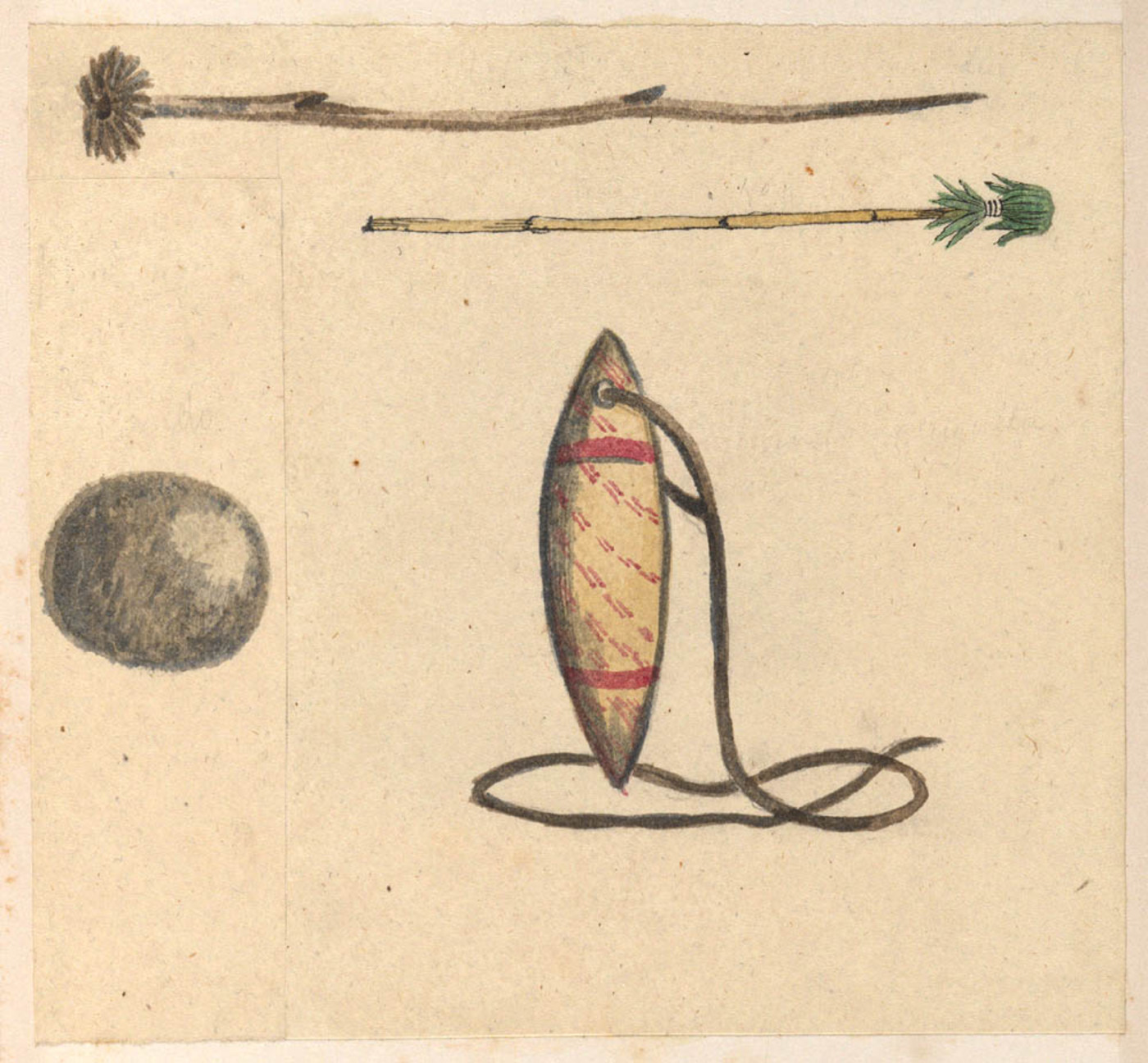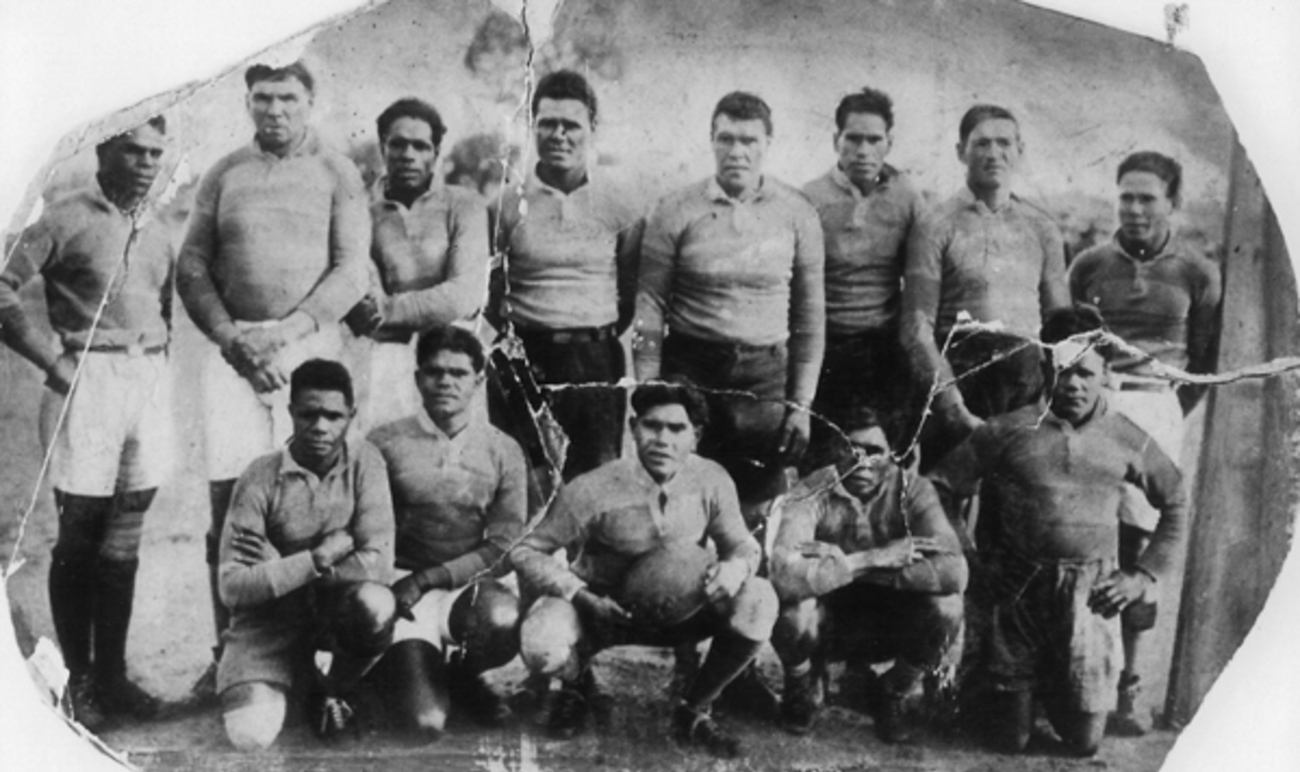'In playing a game at ball which they kicked about — the different totems present two different sides and there were men and women on each side e.g. Garchuka men and women against Wurant men and women. Johnny remembers that he, his mother, and her mother all played on the same side at ball. His cousin George played with the Wurant in the other side.' — Howitt 1837-1930, MS 9356, La Trobe Library, State Library Victoria.
This recollection from Mukjarrawaint man Johnny Connolly is the only known recorded account of someone who took part in the ritual practice and uniquely Australian form of football known as Marngrook. A Gunditjmara word for 'game ball', Marngrook is thought to be the origin of what is now a national sporting institution and icon, Australian Rules Football, or ‘Aussie Rules’ as it’s more colloquially known.
History professor Jenny Hocking uncovered the quote in anthropologist Alfred Howitt’s field notes and correspondence; a copy of these papers can be found in the AIATSIS Collection, MS 52.
Hocking and Nell Reidy have conclusively placed the presence of Aboriginal football in the Western district of Victoria; the precise location where the credited inventor of the game, Tom Wills lived as a child (Marngrook: Tom Wills and the Continuing Denial of Indigenous History, 2016).
There are, however, some who are not convinced of the link, arguing that:
- Tom Wills was not exposed to the Aboriginal game in Western Victoria while he lived there,
- that not enough documentary evidence exists to make the connection,
- that the records that do exist use the term 'ball game' rather than 'football',
- and that Aboriginal football did not exist until after British colonisation and expansion.
Placing Aboriginal football in Western Victoria
Since Tom Wills remained silent on the origins of Australian rules and never referenced an Aboriginal influence, many historians have assumed that this in itself proves that no influence existed.
While AFL historian Gillian Hibbins acknowledges that football was played in Western Victoria by Aboriginal people, she claims that Wills was not in Western Victoria long enough to witness the game in the area (Hibbins in Slattery 2008). A number of historians including Poulter, Judd and Hocking have explored the silencing of Indigenous Australian history in Australian self-identity narratives and believe that Wills' silence and the continual denial of a link has more to do with ‘racism and distrust of Aboriginal people at the time’, and that had Wills made the link it was unlikely to have gathered the widespread support that it eventually did (Poulter in Hay 2017).
The discovery of Johnny Connolly's first-hand account enables more than a contextual link to be made between Aboriginal and Australian football by exploring Wills' childhood in Western Victoria.
Between the ages of four and ten, Tom Wills lived on Lexington and La Rose-Mokepilli stations on the lands of the Mukjarrawaint people where marngrook was played.
His father Horatio had previously taken up ‘an immense tract of land called Ledcourt, 200,000 acres from Mount William, north-east towards the Wimmera and back towards Mount Dryden, just beyond the limits of established European settlement in 1840’ (Hocking & Reidy 2016).
Horatio and Tom both interacted with the Mukjarrawaint, learnt their language, employed them on their properties and Tom’s friends were the Aboriginal children of the area.
Johnny Connolly's testimonial recorded by Howitt of Aboriginal football being played in this area, that he took part in the game in the 1830s to 1840s (Hocking in Ray 2017) and the fact that he worked as a stockman on Ledcourt (one of Horatio Wills’ runs) places 'Marngrook' in the exact area where Tom grew up and so he would have been witness to the game.
That ceremonial activities took place that incorporated marngrook is further corroborated in Horatio Wills' own diary where he states that: ‘this land for some considerable time back an area of general rendezvous’ for the local Indigenous peoples, a place where corroborees, games and other entertainments were traditionally held including football’ (Hocking & Reidy 2016).
A distinctly Australian game
The accepted narrative in the various histories of Australian rules football, including the AFL's official history compiled by Geoff Slattery in 2008 The Australian game of football since 1858, is that in 1858 Tom Wills proposed that cricketers should play football as a way to keep fit in between seasons.
In 1859, Wills founded the Melbourne Football Club and co-wrote the rules for Australian rules football with WJ Hammersly, TH Smith and JB Thompson. Elements of these rules deemed that players should not be 'thrown to the ground' and that 'the ball be kept in the air'.
Along with his cousin Colden Harrison and JB Thompson, Wills set about marketing Australian Rules Football as 'a game of our own' (Poulter, 2007). All of these men had spent time in England playing school rugby and as a means of appealing to colonial pride denigrated rugby as a differentiating strategy for the acceptance of ‘Aussie Rules’.
Historian Barry Judd states that: ‘Its distinctly Australian political, social, and economic setting of the time gave it a character that was not English in form or in tempo. This ‘game of our own’ gained rapid and widespread appeal. Australian football swiftly transitioned from a pastime of the colonial elite to a sport played and spectated by the colonial masses of the Victorian gold rush.
‘It assumed the democratic spirit of the period and became a game that spoke to the ideal of equality. It quickly became a sport where personal wealth, class and educational status mattered little. It spread from Victoria to the colonies of Tasmania, South and Western Australia’ (2016).
Claims have also been made about the link between Australian football and Gaelic football, however a large amount of empirical research has shown that this link doesn’t exist because Gaelic football didn’t become a formal sport until 1883 (Poulter, 2007).
‘Text’ vs ‘Oral’ Documentation…'Ball game' vs 'football'
Hocking suggests that the insistence by football historians for ‘text based evidence about Aboriginal football's own origins before white settlement were nearly "impossible" to produce because Aboriginal culture was not written down but existed in song, dance, stories and art’ (Sutton, 2017).
In addition, that ‘such singularity reflects a conceptual position in which the settler colonial experience is the only perspective from which history is, and can be, told. The prospect of Indigenous engagement with that colonial settler experience, even through the apparently unremarkable medium of Indigenous football, has been peremptorily rejected’ (Hocking & Reidy 2016).
To dismiss that Aboriginal football was a ‘ball game’ rather than ‘football’ because the term 'football' is not commonly used by those who recorded the Aboriginal game is too simplistic as a dismissal strategy. The term ‘football’ was not widely used until the late 1850s and according to the recorded witness accounts the terms were often used interchangeably.
Jim Poulter, who was the first historian to critically examine and put forward the links between Aboriginal and Australian football believes that neo-colonial attitudes are at the heart of ensuring that this hidden history of Aboriginal influence on the early game never came to light (Poulter in Hay 2016).
Pre or post-colonial Aboriginal football
Numerous accounts in the diaries of settlers, explorers, anthropologists as well as artist depictions point to the widespread existence of a ball game not only in South-Eastern Australia but also in the Northern Territory. The game not only served as amusement but also as a means of reinforcing kin relationships.
In a number of these accounts that predate 1858, the date attributed to Tom Wills for the creation of Australian football, extensive descriptions are given that reference the quintessential elements of AFL, that is, keeping the ball in the air, free flowing play and high marking.
The earliest sketch of a 'parndo' or oval football of the Kaurna Adelaide Plains people is found in AW Cawthorne's papers held in the Mitchell Library dating from the 1840s; ‘The players stand together in a ring or a line. One of them kicks the ball in the air, sometimes to the height of fifty feet… The merit of the game is to kick the ball perpendicularly and to keep it in the air as long as possible.'
The Aboriginal Studies Press publication: Australia: William Blandowski's Illustrated encyclopaedia of Aboriginal life contains an etching by Muetzel based on sketches made by anthropogist William Blandowski in 1857.
The etching depicts a game of football being played by the Nyeri Nyeri people of the Mallee region of Victoria in which the ball ‘is not thrown or hit with a bat, but it is kicked in the air with the foot … The aim of the game: never let the ball touch the ground.’(Allen pg. 60).
This etching gives an insight into the cultural context of the game that often involved the coming together for intra and inter clan ceremonies that reinforced social relationships, diplomatic engagement around conflict resolution, feasting and engagement in Aboriginal football.
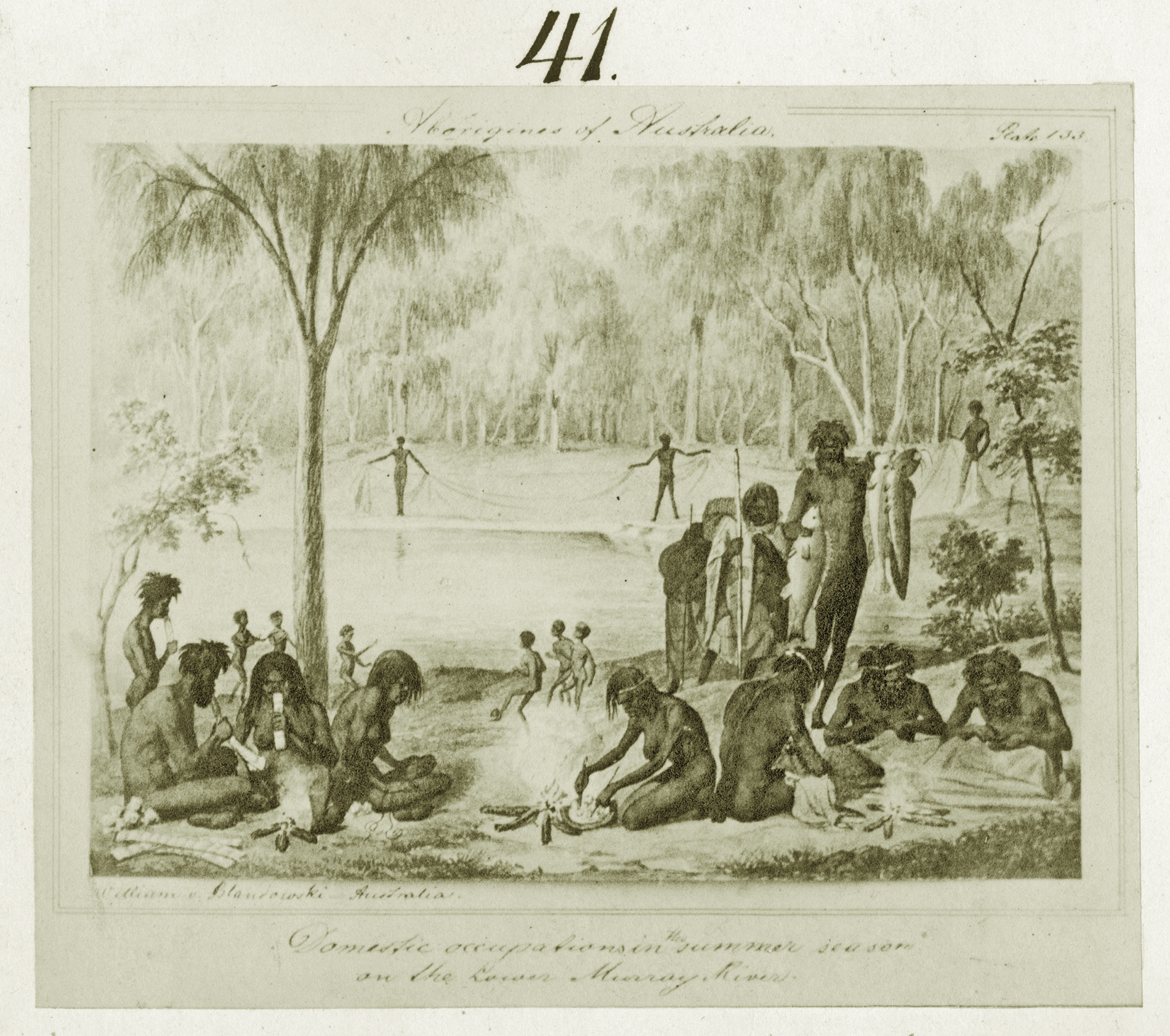
This etching by Gustav Muetzel drawn in the 1850s shows Aboriginal people playing football or Marngrook. Published in Australia in 142 photographic images: From 10 years experience compiled by Wilhelm v. Blandowski, Cambridge. Courtesy Haddon Library, Cambridge.
This etching by Gustav Muetzel drawn in the 1850s shows Aboriginal people playing football or Marngrook. Published in Australia in 142 photographic images: From 10 years experience compiled by Wilhelm v. Blandowski, Cambridge. Courtesy Haddon Library, Cambridge.
In the 1878 book The Aborigines of Victoria, Robert Brough Smyth quotes William Thomas, a Protector of Aborigines in Victoria, who stated that in about 1841 he had witnessed Wurundjeri Aboriginal people east of Melbourne playing marngrook.

In the 1878 book 'The Aborigines of Victoria', Robert Brough Smyth quotes William Thomas, a Protector of Aborigines in Victoria, who stated that in about 1841 he had witnessed Wurundjeri Aboriginal people east of Melbourne playing marngrook.
In the 1878 book 'The Aborigines of Victoria', Robert Brough Smyth quotes William Thomas, a Protector of Aborigines in Victoria, who stated that in about 1841 he had witnessed Wurundjeri Aboriginal people east of Melbourne playing marngrook.
A number of accounts including those of Cawthorne, Connolly, Howitt and Beveridge describe the involvement of women in these games. Beveridge in particular provides the following description of the start of the game.

An extract from Beveridge,1885, Of the Aborigines inhabiting the Great lacustrine and Riverine Depression of the Lower Murray, Lower Murrumbidgee, Lower Lachlan and Lower Darling that describes the involvement of women in the game of Margngrook.
An extract from Beveridge,1885, Of the Aborigines inhabiting the Great lacustrine and Riverine Depression of the Lower Murray, Lower Murrumbidgee, Lower Lachlan and Lower Darling that describes the involvement of women in the game of Margngrook.
It seems timely that in 2017 women have been reinstated in this game with the creation of the AFL Women's League.
With the awakening and revival of sleeping Aboriginal languages including the Kaurna Adelaide plains language, Australian Rules football has come full circle and Australians now have a way to use this language to barrack for their favourite footy teams.
Kaurna language organisation Kaurna Warra Pintyanthi, together with Adelaide University linguist Rob Amery, have developed language teaching materials that include football related phrases as a means for people to barrack for Port Adelaide and the Adelaide Crows resulting in the following posters.
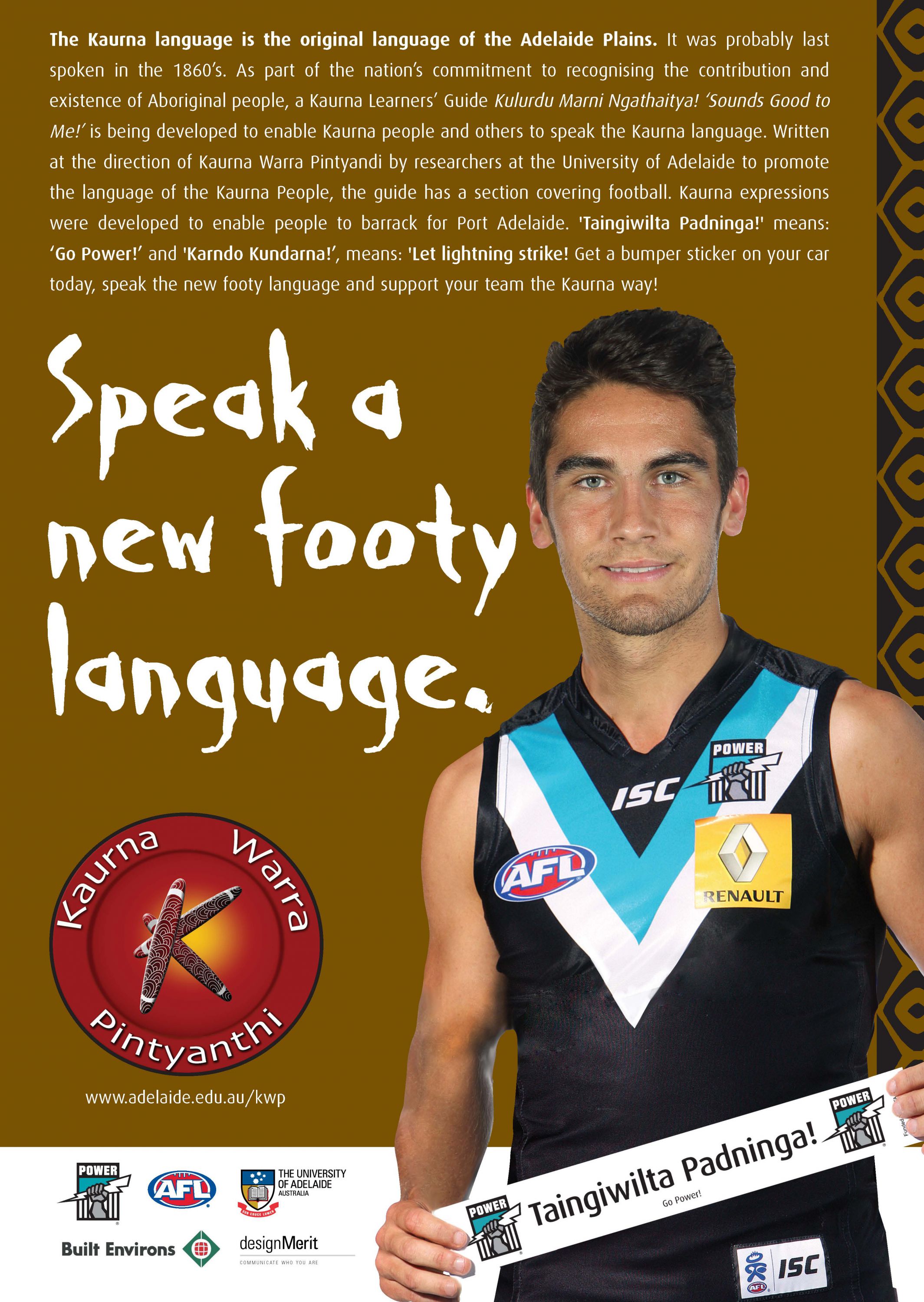
Adelaide Crows poster. Kaurna language organisation Kaurna Warra Pintyanthi together with Adelaide University linguist Rob Amery have developed language teaching materials that include football related phrases as a means for people to barrack for Port Adelaide and the Adelaide Crows.
Adelaide Crows poster. Kaurna language organisation Kaurna Warra Pintyanthi together with Adelaide University linguist Rob Amery have developed language teaching materials that include football related phrases as a means for people to barrack for Port Adelaide and the Adelaide Crows.
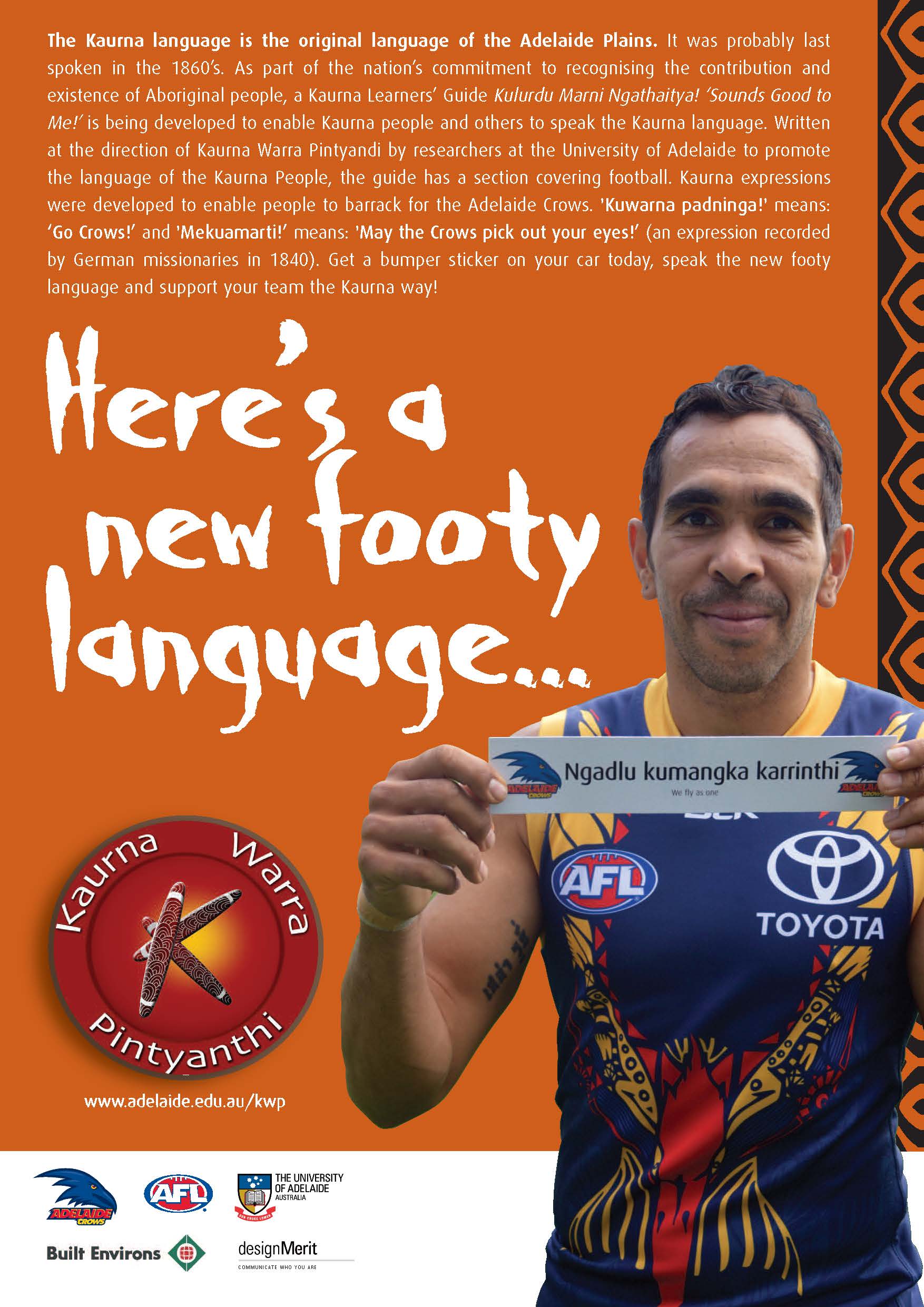
Port Adelaide poster. Kaurna language organisation Kaurna Warra Pintyanthi together with Adelaide University linguist Rob Amery have developed language teaching materials that include football related phrases as a means for people to barrack for Port Adelaide and the Adelaide Crows.
Port Adelaide poster. Kaurna language organisation Kaurna Warra Pintyanthi together with Adelaide University linguist Rob Amery have developed language teaching materials that include football related phrases as a means for people to barrack for Port Adelaide and the Adelaide Crows.
Kaurna and Narrunga man and language teacher Jack Buckskin has devoted his life to renewing his languages and cultures. His belief that languages die unless they are spoken has led to the production of the Kaurna Language Learning Series that is available on YouTube.
One of these videos provides AFL terms in Kaurna where we learn that 'warni tantunthi' is 'drop kick', 'nurlinthi' is 'bending', 'yurdina yarku tatunthu' 'kick it with your left leg', 'turntuntu yarku tatunthu' 'kick it with your right leg', 'pungkunthi' 'handball', 'kurntanthu' 'punch the ball' and 'murtpamanku' 'mark'.
Watch a video of Jack Buckskin teaching some of the Kaurna terms used in football.
The exploration of the Aboriginal influence on Australian football provides an example of how inextricably Aboriginal culture is woven into the fabric of our Australian heritage.
Perhaps as Australians we can learn a new 'football language' that is in keeping with its Aboriginal origins. As Jack Buckskin says, ‘Feel free to use them, the thing that will work to your advantage is that no one will know what you are talking about!’.
References
- Allen, H (ed) 2010, Australia: William Blandowski’s encyclopaedia of Aboriginal Australia, Aboriginal Studies Press, Canberra.
- Beveridge, P 1885. Of the Aborigines inhabiting the Great lacustrine and Riverine Depression of the Lower Murray, Lower Murrumbidgee, Lower Lachlan and Lower Darling.
- Cawthorne, W A 1855. Album of sketches of the Aborigines of South Australia.
- Dawson, J 1881. Australian Aborigines: The Languages and Customs of Several Tribes of Aborigines in the Western District of Victoria, Australia, George Robertson, Melbourne.
- Hay, R 2016. Tom Wills country or how the myth has taken over.
- Hocking, J & Reidy, N 2016. Marngrook, Tom Wills and the Continuing Denial of Indigenous History.
- Judd, B 2016. The Aboriginal football ethic: where the rules get flexible.
- Poulter, J 2007. Aboriginal football the Indigenous game.
- Slattery, G 2008. The Australian game of football since 1858, GSP Books, Melbourne, 2008.
- Smyth, R B 1878. The Aborigines of Victoria: with notes relating to the habits of the natives of other parts of Australia and Tasmania, compiled from various sources for the government of Victoria. Available from: https://archive.org/details/aboriginesofvict01smyt [18 May 2017].
- Sutton, M 2017. Indigenous influence on AFL creation confirmed by historical transcripts, historian says.
- Howitt, A W 1837-1930. Papers MS 9356 Box 1053/5 (c). State Library of Victoria.
- Australian Sports Commission 2010. Yulunga.
